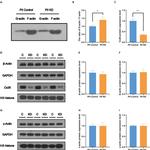Search Thermo Fisher Scientific
Invitrogen
E-cadherin Monoclonal Antibody (ECCD-1)
FIGURE: 1 / 1
E-cadherin Antibody (13-1800) in WB

Product Details
13-1800
Species Reactivity
Published species
Host/Isotype
Class
Type
Clone
Immunogen
Conjugate
Form
Concentration
Purification
Storage buffer
Contains
Storage conditions
Shipping conditions
RRID
Product Specific Information
Source: Monoclonal antibody was obtained by fusing the P3-X63-Ag8 mouse myeloma cell line with spleen cells of Wistar rat after immunization with mouse teratocarcinoma cell line F9.
Specificity: This antibody specifically reacts with mouse E-cadherin. This antibody inhibits E-cadherin dependent cell-cell contact.
Cross reactivity: This antibody does not react with human, bovine, chicken or dog E-cadherin.
Storage: 4°C This product does not contain preservative. The stock solution (2.0 mg/mL) should be stored in aliquots at -20°C for 1 year, or should be stored at 4°C for 6 months after adding 0.1% sodium azide. Avoid repeated freeze-thaw cycles.
Reconstitution: Dissolve the lyophilized antibody in 50 µL of distilled water (final concentration: 2.0 mg/mL). This solution can be used as a stock solution. If dilution is necessary for your application, dilute the stock solution with the following Dilution solution just prior to use. When the entire amount of antibody is to be used over a short time period, it may be dissolved directly in 500 µL or more of the Dilution solution. Be sure to store the antibody at a minimum concentration of 2.0 mg/mL. A lower antibody concentration may result in decreased stability. Reconstituted antibody solution should contain 0.1% sodium azide as a preservative when stored at 4°C.
Target Information
E-Cadherin (epithelial cadherin) is a classical cadherin from the cadherin (alcium dependent adhesion protein) superfamily. The encoded protein is a calcium dependent cell-cell adhesion glycoprotein comprised of five extracellular cadherin repeats, a transmembrane region and a highly conserved cytoplasmic tail. Mutations in this gene are correlated with gastric, breast, colorectal, thyroid and ovarian cancer. Loss of function is thought to contribute to progression in cancer by increasing proliferation, invasion, and/or metastasis. The ectodomain of this protein mediates bacterial adhesion to mammalian cells and the cytoplasmic domain is required for internalization. Identified transcript variants arise from mutation at consensus splice sites. E-cadherin plays a central role in the growth and development of cells by controlling tissue architecture, and maintenance of tissue integrity. In humans, E-cadherin is encoded by the CDH1 gene present on chromosome 16. Studies have demonstrated that reduction and/or loss of E-cadherin expression in carcinomas correlates positively with the potential of these tumors for invasion and metastasis.
For Research Use Only. Not for use in diagnostic procedures. Not for resale without express authorization.
Bioinformatics
Protein Aliases: ARC-1; cadherin e; Cadherin-1; cadherin-E; CD324; E-cadherin; Ecadherin; Epithelial cadherin; Uvomorulin
Gene Aliases: AA960649; Cdh1; E-cad; Ecad; L-CAM; Um; UVO
UniProt ID: (Mouse) P09803
Entrez Gene ID: (Mouse) 12550

Performance Guarantee
If an Invitrogen™ antibody doesn't perform as described on our website or datasheet,we'll replace the product at no cost to you, or provide you with a credit for a future purchase.*
Learn more
We're here to help
Get expert recommendations for common problems or connect directly with an on staff expert for technical assistance related to applications, equipment and general product use.
Contact tech support
